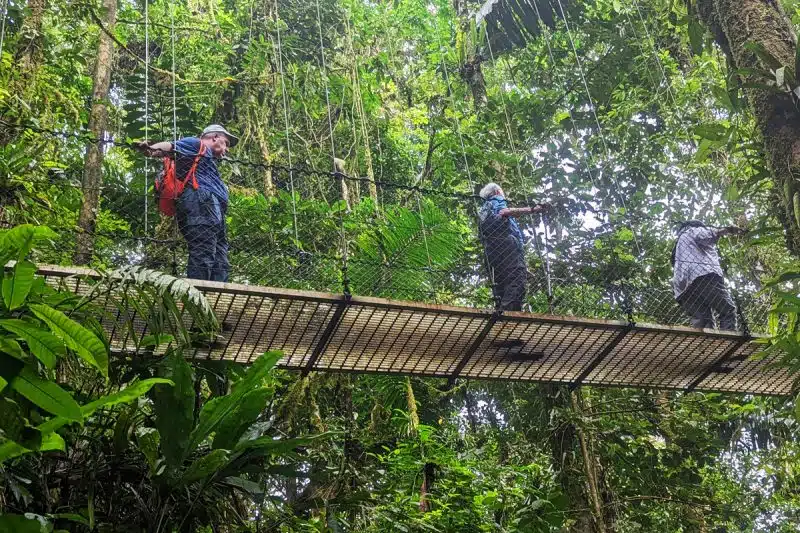Dry Tortugas camping is an incredible experience. There’s no feeling quite like setting up your tent for the night and realizing you are within 50 feet of both a historic 19th-century military fort and a gorgeous beach with crystal-clear water and incredible snorkeling.
While at the same time realizing you’re 70 miles away from the hustle and bustle of civilization!

Camping at Dry Tortugas National Park (a chain of islands located in the Gulf of Mexico to the west of Key West, Florida) is unlike any other camping experience you might have.
The only way to get there is by private boat, charter sea plane, or the Yankee Freedom ferry, which runs daily and costs roughly $220 for the round-trip.
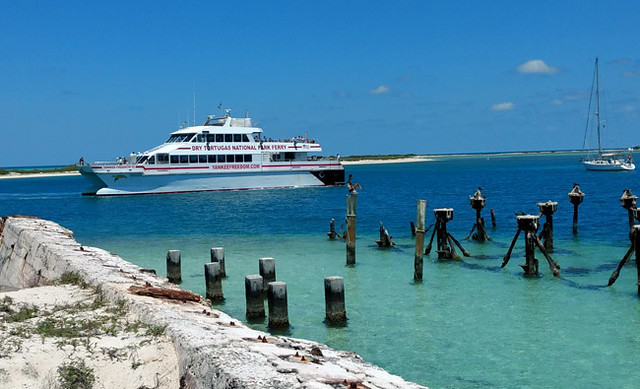
No, it’s not cheap, so this is not going to be a last-minute vacation for most people. If you plan on taking the ferry (as most visitors do) to camp at Dry Tortugas, you’ll need to plan your trip well in advance in order to secure a ticket.
Here’s everything you need to know. Consider this my Tortugas camping review.
Dry Tortugas Camping: Making your reservation
There are no official camping reservations at Dry Tortugas, but the NPS limits the number of campers coming over on the Yankee Freedom to 10 per day to ensure that all campers have a spot.
Ferry reservations for campers fill up very quickly, so you’ll need to start planning several months ahead of time to make this happen.
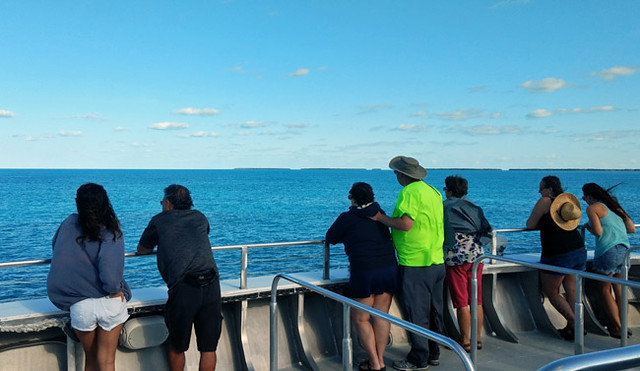
While regular Yankee Freedom passengers can book their reservations online, campers have to call the office for reservations.
To give you an idea of the advance timeline, I called on January 31 and got the very last camping reservation for three days in mid-May.
I had hoped to camp for two nights, but I was forced to stay for three to fit into the one remaining slot the NPS had for campers that week. All camping is primitive. There’s a bathroom, but nothing else – not even drinking water.
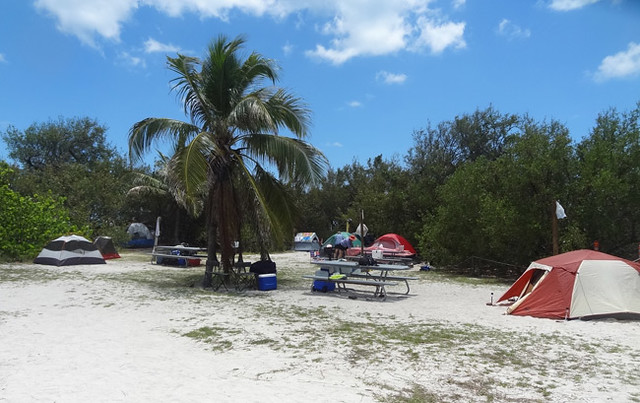
Boarding the Yankee Freedom Ferry
Campers can start arriving at 6:30 am to board the ferry. This means you’ll have to stay the night before in Key West, which is very expensive, like the entire Florida Keys.
To save money, consider the only hostel in town, the Seashell Motel and Hostel or check Airbnb (although they don’t have a ton of listings here.)
Upon arrival, you’ll find wheelbarrows to take your luggage over to the ship. Bring all the food and water you’ll need because none is available on the island of Garden Key, where you’ll be staying.
You can, however, buy lunch or snacks on the ferry when it arrives each afternoon, and prices are surprisingly reasonable.
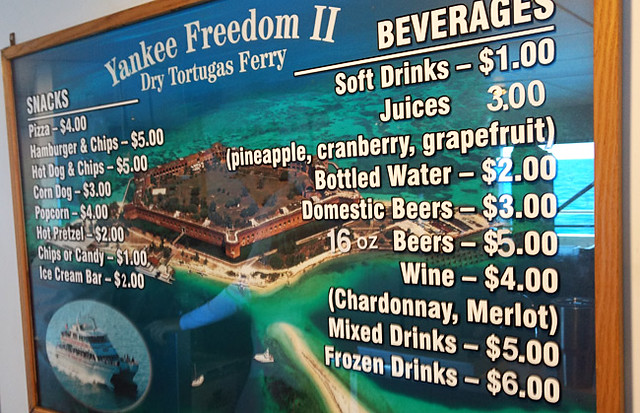
I packed ultra-light because I was concerned about carrying around heavy bags, but it turns out there’s very little carrying necessary.
Once you arrive on the island, you’ll have access to more wheelbarrows to transport your belongings directly to your campsite.
So if you’re concerned that all the gallons of water you’re bringing are too heavy, don’t worry; it won’t be an issue.

You cannot bring any flammable accelerants or propane canisters on the ship, so your only options for starting fires are charcoal or sterno cans.
Usually when I camp, I don’t bother cooking, because it’s too much work. So I ended up roughing it for three days with a bunch of mediocre room-temperature foods.
Think jerky and cheese, peanut butter and jelly sandwiches, apples and bananas, crackers and nuts. I was grateful when a family at another site invited me to join them for yummy veggie tacos one night.
Breakfast is free on the ship, and passengers also get one free lunch on the ship during their stay.
Campers are advised to save the free lunch until their final day, when their gear will already be packed up in preparation for departure. Lunch is simple but satisfying.

It doesn’t get very cold at Dry Tortugas, not even during winter. I actually went without a sleeping bag and just brought two sheets, which were sufficient.
The coldest time of year is January, when high temperatures average 73 F (23 C) and lows average 64 F (18 C.)
Securing your campsite
There are only 10 campsites at Dry Tortugas. Though the NPS limits the number of campers coming over on the ferry, private boaters can and do arrive on the island whenever they like, and they can take up campsites as well.
This means there’s a good chance the camping spots will be full when you arrive.
Once the ferry arrives, campers are gathered together for an orientation. Then, you are free to get your bags, load them up, and wheel them over to the campsite.
If you are traveling in a group, once the orientation ends, you should send someone over to quickly secure an available campsite while the rest of your party packs up their bags.
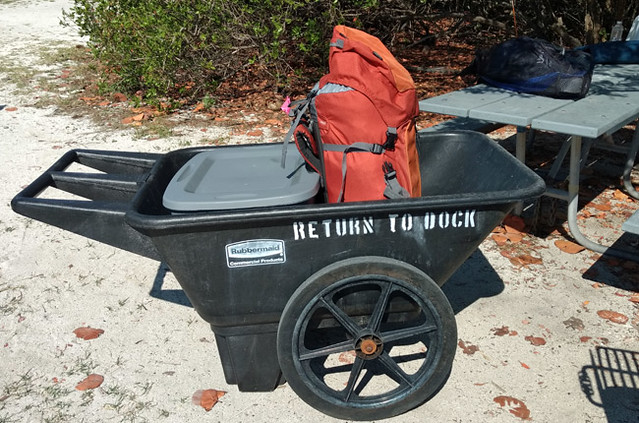
Solo campers (like me) should resign yourselves to the possibility that all campsites will be taken by the time you drag your gear over there. If that’s the case, you will be stuck setting up on the grass overflow area.
The overflow area is in the direct sun, so it will be quite uncomfortable during the heat of the day. The only good news is that you’ll be right in front of the fort, leading to some cool photos:
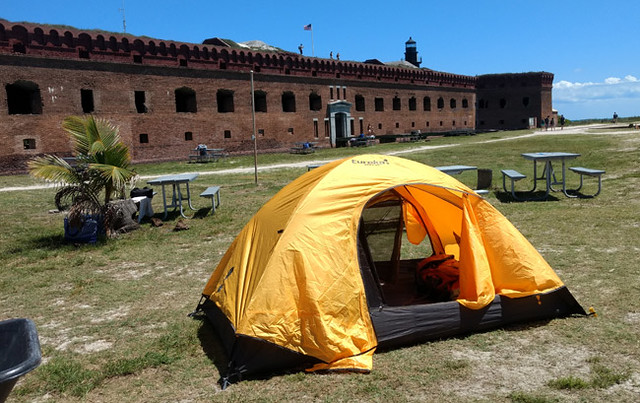
Really, how many places in America can you set up your tent right in front of a historic fort? There’s something to be said for that.
Also, if you’re camping for more than one night, you’ll most likely to be able to move into a normal campsite the next morning when other campers vacate their space. I ended up in a normal shaded campsite for the final two nights.
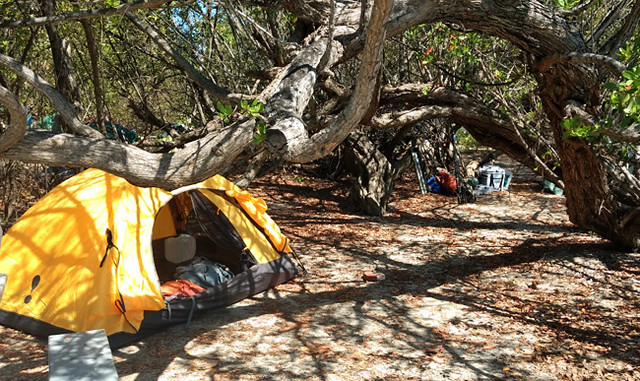
What Dry Tortugas campsites look like
The reason I wanted to stay at Tortugas was because of the solitude. Since the ferry leaves every afternoon, and the only people left behind on the island overnight are the small number of campers and rangers, I had imagined that I would have my own tropical island mostly to myself.
That wasn’t the case at all. Because so many private boaters showed up, there were roughly 30-60 people on the island each night, with tents together in close quarters.
It wasn’t the secluded paradise I had hoped for, but it was still a fun experience being in such a remote location.
There is almost no shade on Garden Key, but the shade that does exist is in the campground. Most of the sites have trees or small brush that offers shade and welcome relief from the beating sun. A couple do not have direct shade.

There are rats on the island, and they come out at night looking for your food. They have been known to chew through tents and bags, so campers are strongly urged to keep all food in hardside containers on picnic tables outside their tents.
I bought a cheap plastic bin for $5 in the Key West store and that was perfect. During a 2 am bathroom break, I did see a couple rats running around, and they were large, so you don’t want to mess with them.
Mosquitoes are virtually nonexistent since there’s no fresh water on the island. I did not need bug repellent at all. You will be visited by lots of hermit crabs and a few lizards.
This guy kept hanging around my table and I couldn’t figure out why, until I realized he was attracted to the liquid or scent in the bag of baby wipes:
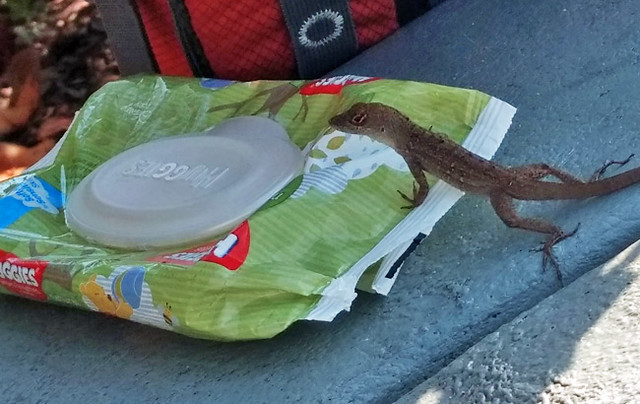
Here’s a park ranger tip that isn’t publicized: near the outhouse, you’ll find a plastic bin beneath the steps containing leftover supplies from previous campers.
Here you might find an extra gallon of water, or plastic silverware or plates. Check it out if you need it, and leave your extra supplies when you depart.
The Yankee Freedom advertises that showers are available on the ship each afternoon when it arrives, but the showers are just a couple of fresh water sprinklers on the back deck that you can use to rinse off.
These are not the kind of showers where you can lather up and wash bodily crevices in private.
What’s the best time of year to visit Dry Tortugas?
It’s hard to say exactly which months are most and least crowded at Dry Tortugas, because people visit at different times for different reasons.
First, the weather doesn’t vary a whole lot, and the islands stay warm even in winter (usually 60s F are as low as it gets, with occasional nights in the 50s.)
However, during winter the waters can get more choppy and that increases the odds that the ferry won’t be able to make the trip due to weather.
Conversely, summer brings very hot temperatures and warmer waters perfect for snorkeling. Since many families and kids have summer off, they’ll be visiting during that time.
You may get rain any time of year in this part of Florida. The wettest months are September (13 rainy days per year) and August (11.) April and May are the dryest, with an average of 4 rainy days during each of those months.
Because there are so few campsites at Dry Tortugas National Park, there really are no guarantees at all when it comes to crowd size.
Perhaps the least crowded time is November and early December, in the weeks just before holiday travelers and northern snowbirds head south for the winter. Of course, June to November is hurricane season, so there’s always that risk.
What does all this conflicting information mean? Basically, there are pros and cons with Dry Tortugas camping, no matter which time of year you pick.
My advice is to simply come when it suits your schedule, rather than trying to outsmart other travelers by finding the “least crowded” time. Camping near Fort Jefferson will be epic regardless of the month you choose.
Other important camping information and tips to keep in mind:
How much does it cost to camp at Dry Tortugas? As of 2024, the Yankee Freedom costs $220 for adults (or $210 during the less-popular the summer months), and $165 for kids ($155 during summer.)
Students, active military, and seniors can get a $10 discount. Campers pay extra, though: $240 for the round-trip.
Yeah, that’s expensive. Especially when you factor in lodging the night before in Key West, and your campground fees. Camping payments must be made in cash. You fill out an envelope and deposit your dollars ($15-30 per night) at the pay station.
There was a single American crocodile that used to live here, but he was removed and relocated by rangers a few years back.
The baggage area on the Yankee Freedom will get wet on the trip over. Campers are advised to put their gear in waterproof packs, or use plastic tote bins.
The Yankee Freedom has a capacity of 250 people (125 interior seats, and 125 outside on the deck.)
The bathrooms on the island are glorified outhouses. They have a composting toilet, but don’t expect anything fancy. During the day, when the ship is on the island, you can use the bathrooms on the ship. Definitely take advantage of this option!
All gear must be “free-standing.” No hammocks between trees, no ropes or laundry lines hanging from trees.
What’s the limit on how much stuff you can bring? The Tortugas website says campers are allowed 60 pounds of gear each. That’s a really generous allowance, and it doesn’t include water jugs. You can bring as much extra water as you like.
Bring a garbage bag to pack out all your trash. Alcohol is permitted on Dry Tortugas, but glass bottles are not. Bring plastic bottles of wine or beer if desired.
That said, our bags weren’t searched when we visited, so if you choose to bring alcohol keep that in mind. The island definitely isn’t a party kind of place. People are generally quiet and there to enjoy the nature.
If you’re thinking of going alone, I’d go for it. As mentioned, my trip was solo, and it’s a place where a solo traveler can easily enjoy the experience. Make friends with your camping neighbors, or just enjoy the solitude in paradise.
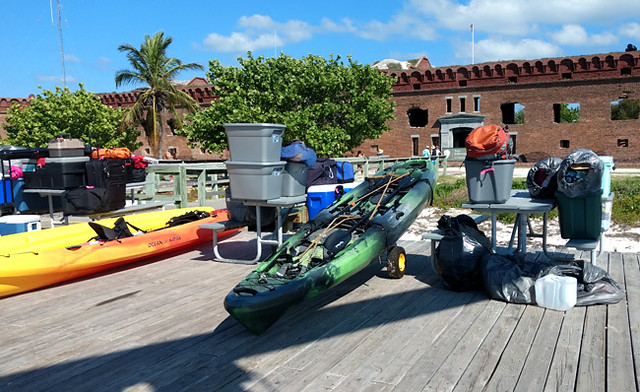
And finally, why is it called Dry Tortugas? That’s because when explorer Ponce de Leon reached the area in 1513, he found hundreds of turtles (“tortugas” in Spanish.)
The “dry” part refers to the fact that there is no freshwater available on the islands for drinking. So in navigational terms, the islands are considered dry.
Dry Tortugas Camping Checklist
Here’s the most basic checklist of what you should bring on a camping trip to Dry Tortugas.
• Tent
• Sleeping bag / camping pad / pillow
• WATER – there’s no limit on how much you can bring, so load up
• Food – meals and snacks (good snack options include fruit, nuts, jerky, crackers)
• Charcoal or sterno cans if you plan to cook
• Cooler for colder foods & beverages if desired
• Sunscreen & hat
• Lightweight clothing
• Poncho
• Toiletries – toothbrush, toothpaste, deodorant
• Wet wipes
• Bug spray if desired (though mosquitoes are not a big problem)
• Snorkel gear
• Kayak if desired (make sure to have NPS permit)
• Towel
• CASH – pay your camping fee ($15/day) in cash, and bring extra $ to buy ferry food & souvenirs
• National Parks Passport – bring the official NPS book so you can get your park stamp
• Camera
• Portable charger for your phone
• Flashlight
• Books or other reading material if desired
Got any more suggestions that I should add to the Dry Tortugas camping checklist? Leave a comment and let me know!
Enjoy the island!
Once your campsite is secure, go enjoy all that Garden Key has to offer. Fort Jefferson is full of history and you can spend a few hours there seeing the old cannons and peering out through the windows.
Late in the afternoon (around 4-6 pm), if you’re sitting on a picnic table near the dock, expect to see hundreds of hermit crabs come out and start wandering around.
Snorkeling and swimming at the beach are the other main options. The snorkeling here is amazing, with tons of colorful fish and other tropical critters, so you’ll want to take advantage of the opportunity.
You can bring your own snorkel – I absolutely love my full-face snorkel mask – or you can borrow a snorkel and flippers from the NPS for free.
What about kayaking? Unfortunately, you can’t rent kayaks on the island. You have to bring your kayak from home. The Yankee Freedom only allows a few kayaks per ferry trip, so check in with them in advance to reserve your spot.
To kayak in Dry Tortugas, you’ll have to fill out extensive paperwork (including a boating permit) and have rescue equipment with you such as a portable VHF radio. See the rest of the kayaking requirements here.
And don’t forget to take advantage of the sunsets and sunrises!
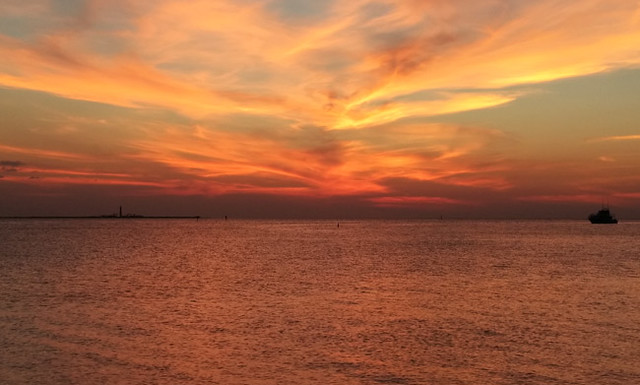
Would you head to this remote place for a Dry Tortugas camping experience?



